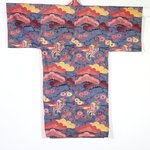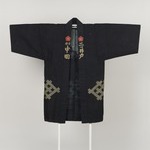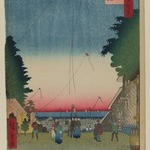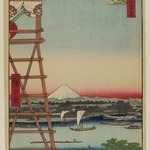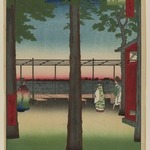
New Year's Eve Foxfires at the Changing Tree, Oji, No. 118 from One Hundred Famous Views of Edo
Utagawa Hiroshige
Asian Art
In the late 1850s, while Japanese color prints were dominated by themes of the fantastic, Hiroshige emphasized the realities of the observed world in his work. However, here he has ventured into the world of spirits. It was believed that on New Year's Eve all the foxes of the surrounding provinces would gather at a particular tree near Oji Inari Shrine, the headquarters of the regional cult of the god Inari. There the foxes would change their dress for a visit to the shrine, where they would be given orders for the coming year. On the way, the animals would emit distinctive flames by which local farmers were able to predict the crops of the coming year.
MEDIUM
Woodblock print
DATES
9th month of 1857
PERIOD
Edo Period, Ansei Era
DIMENSIONS
sheet: 14 3/16 x 9 1/4 in. (36.0 x 23.5 cm);
image: 13 3/8 x 8 3/4 in. (34.0 x 22.2 cm) (show scale)



MARKINGS
No publisher's seal visible, probably lost when left margin was trimmed.
SIGNATURE
Hiroshige-ga
COLLECTIONS
Asian Art
ACCESSION NUMBER
30.1478.118
CREDIT LINE
Gift of Anna Ferris
PROVENANCE
Prior to 1930, provenance not yet documented; by 1930, acquired by Anna Ferris of Summit, NJ; 1930, gift of Anna Ferris to the Brooklyn Museum.
Provenance FAQ
CATALOGUE DESCRIPTION
This unique print is the only one in the entire series that involves fantasy and is generally included among the "best three," together with prints 58 and 107. On the last day of the year, according to legend, all of the foxes if the eight Kanto provinces would gather at a particular tree near Oji Inari Shrine. They would change their dress before visiting the shine, where they would be given orders for the coming year. On the way they would breathe flames (kitsunebi) by which local farmers were able to predict the success of the crops of the coming year, either by the shadows cast by the flames or by their numbers. The word "foxfire" exists in English as a literal translation of Kitsunebi; both words are used to explain strange lights at night, such as the burning of swamp gases, and both were ascribed to the fox. In creating this image, Hiroshige relied on a composition in the Edo Meisho Zue (vol. V) which shows an old hackberry tree (enoki), backed by a pine. Haystacks are shown on one side and there are touches of green on the pine behind to the left, in overprinting on the haystacks and at the tips of the trees in the distance to the right. Red bokashi is used at the base of the yellow flames of the foxes in the foreground and there are some sixty-odd more foxes breathing fire in the distance. Although the Japanese considered foxes to have supernatural powers, they were a common sight in the city of Edo, especially in the Oji district. The "changing tree" stump has been preserved in a small shrine. A firebombing raid threatened to destroy the area in 1945, but the flames came no further than this point. After the war the residents constructed a shrine and planted a new tree, which is presently seen at Shozoku Inari Shrine.
EXHIBITIONS
MUSEUM LOCATION
This item is not on view
CAPTION
Utagawa Hiroshige (Japanese, 1797–1858). New Year's Eve Foxfires at the Changing Tree, Oji, No. 118 from One Hundred Famous Views of Edo, 9th month of 1857. Woodblock print, sheet: 14 3/16 x 9 1/4 in. (36.0 x 23.5 cm);. Brooklyn Museum, Gift of Anna Ferris, 30.1478.118 (Photo: Brooklyn Museum, 30.1478.118_PS20.jpg)
IMAGE
overall, 30.1478.118_PS20.jpg. Brooklyn Museum photograph, 2023
"CUR" at the beginning of an image file name means that the image was created by a curatorial staff member. These study images may be digital point-and-shoot photographs, when we don\'t yet have high-quality studio photography, or they may be scans of older negatives, slides, or photographic prints, providing historical documentation of the object.
RIGHTS STATEMENT
No known copyright restrictions
This work may be in the public domain in the United States. Works created by United States and non-United States nationals published prior to 1923 are in the public domain, subject to the terms of any applicable treaty or agreement.
You may download and use Brooklyn Museum images of this work. Please include caption information from this page and credit the Brooklyn Museum. If you need a high resolution file, please fill out our online application form (charges apply).
The Museum does not warrant that the use of this work will not infringe on the rights of third parties, such as artists or artists' heirs holding the rights to the work. It is your responsibility to determine and satisfy copyright or other use restrictions before copying, transmitting, or making other use of protected items beyond that allowed by "fair use," as such term is understood under the United States Copyright Act.
The Brooklyn Museum makes no representations or warranties with respect to the application or terms of any international agreement governing copyright protection in the United States for works created by foreign nationals.
For further information about copyright, we recommend resources at the United States Library of Congress, Cornell University, Copyright and Cultural Institutions: Guidelines for U.S. Libraries, Archives, and Museums, and Copyright Watch.
For more information about the Museum's rights project, including how rights types are assigned, please see our blog posts on copyright.
If you have any information regarding this work and rights to it, please contact copyright@brooklynmuseum.org.
RECORD COMPLETENESS
Not every record you will find here is complete. More information is available for some works than for others, and some entries have been updated more recently. Records are frequently reviewed and revised, and we welcome any additional information you might have.













